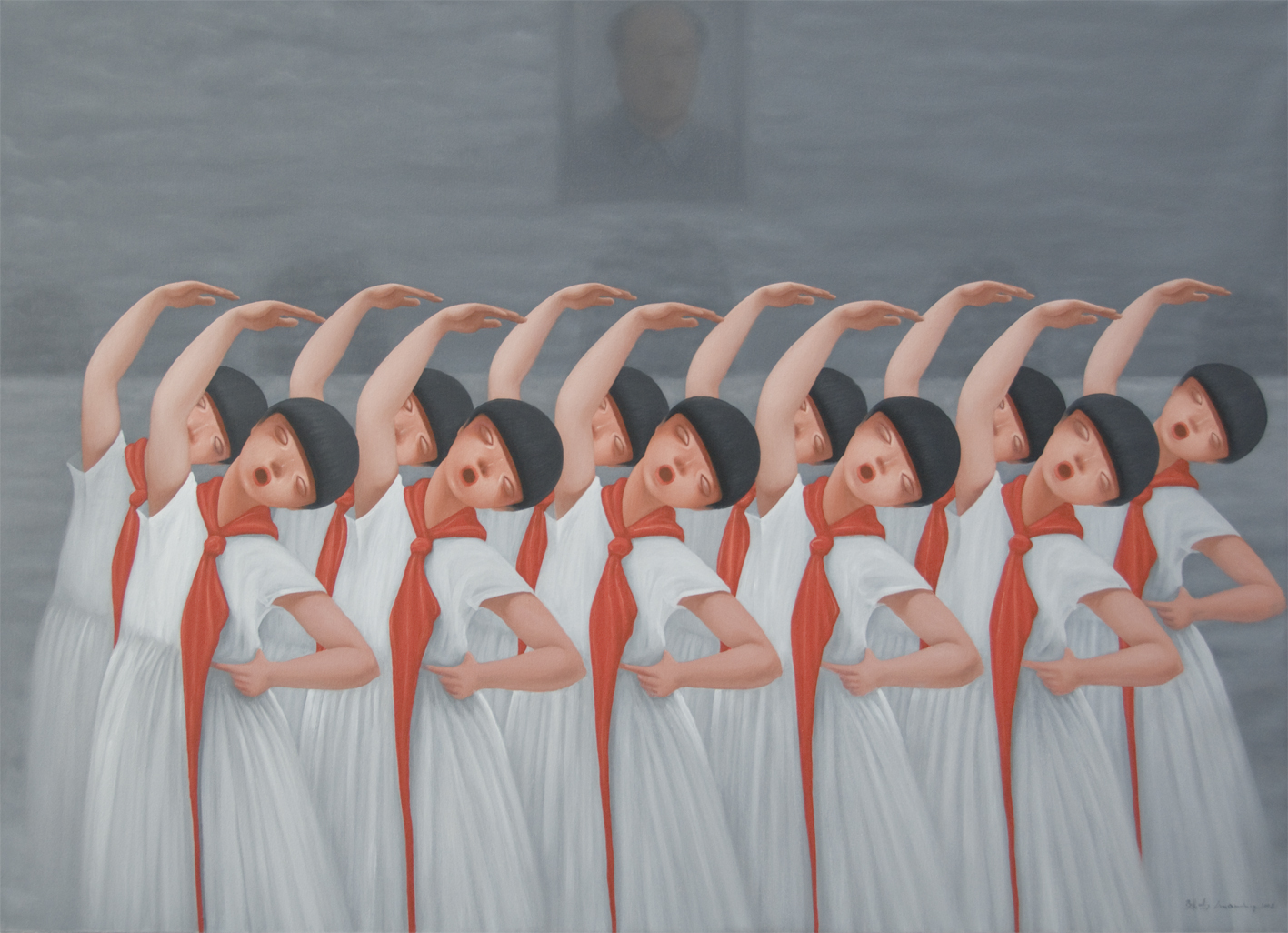Preserving Personal Historical Memory
–On the Paintings of Liu Qiming
By Wang Lin
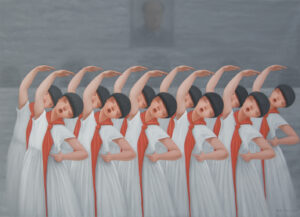
Children Series NO.8/Paintings/Liu Qiming/65.4 W x 47.2 H x 2.8 D in/2006
In a society that values collectivism, even the concept of human-centered thinking is easily contaminated. When “people” become “citizens,” individuals are often excluded. For Chinese feudal cultural traditions, the importance of the people lies in their being the foundation of royal rule, as the saying goes, “The people are the most important, the emperor is secondary, and the state is tertiary.” This is a prerequisite for judging whether today’s society has truly entered modernity, namely, the degree to which individual freedom is realized in the social system and social life. The constitution stipulates the democratic rights of every citizen, but in reality, we cannot achieve them. The current situation of nominal existence but practical non-existence of citizens’ rights has had a profound impact on the spiritual psychology of the Chinese people. The collective amnesia of mainland artists regarding major political and historical events is a significant example. Many artists use and even abuse the cultural resources of the Mao era but almost no one re-narrates or reflects on the historical disasters of that time. Historical subject matter creation has been superficially explored in contemporary art, and it remains a field dominated by the official ideology and realism narrative hegemony of political bias, rather than historical accuracy.
This is why I was deeply moved when I saw Liu Qiming focusing on historical memory in his works.
Liu Qiming approaches history from the perspective of personal memory. Whether it’s works based on era names, or works based on historical narration, such as “Revolutionary Model,” “Anti-Terrorist Elite,” and “Olympic Vision,” the painter never directly depicts political and historical events. He always uses psychological symbolism to describe his feelings about the fading historical memory. For example, in his “My 1989” series, some works feature only a faint chain of people suspended in the sky, or figures leaving motion poses on the clouds and water. These images that have been collectively forgotten by Chinese people in today’s society appear so small and unreal in the painting. It is not only the painter’s grief for the deliberately abandoned historical experience but also the art’s lament for the spiritual reality of the consumer era. It is in this heartfelt grief and lament that the artist hopes to preserve personal historical memory. This is poetic history and historical poetry.
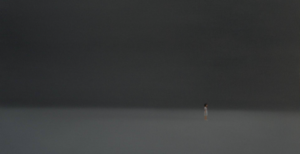
5.12 No.4 /Paintings/Liu Qiming/ 71 W x 35.5H x 1.8 D in/2008
Liu Qiming’s paintings are spacious and desolate, quiet and vast. He always uses grayish colors such as gray-blue, gray-green, or pale red-gray to create a hazy and ambiguous background, even the cloud and water interface itself. Among them are the ripples of cloud and water, the halo of daylight, and the typical political symbol of Tiananmen Square, sometimes obscure, sometimes visible. This Chinese classical gatehouse appears among the clouds and water, creating a surreal situation and adding a sense of emptiness and ethereality to the painter’s poetic imagery. At the same time, it implies the historical relevance of personal narration with its political symbolism.
The portrayal of people by painters is a long-distance communication between the smallness of space and the passing of time. Whether they are walking, wandering, or in a sporting posture, hanging on tree branches or ropes, the painters intentionally use translucent backgrounds to depict them like silhouettes, thin, tiny, floating, rootless, unsupported, beginningless and endless, helpless and yet fated. These are the abandoned people, abandoned and forgotten by official power, power consciousness, and ideology. In contemporary China, which is a mixture of market economy, consumerism, and collective society, the overall collapse of intellectuals, the impatience for art creation, and the weakness of historical consciousness are interdependent. Liu Qiming is deeply aware of this situation and his works reveal a deep sense of loneliness and desolation, which is not only on the scene but also genuine. Only in this way can art reveal the reality of spiritual reality by revealing it through its sensitive and subtle psychological reactions.
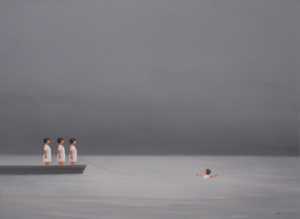
5.12 No.3 /Paintings/Liu Qiming/ 71 W x 59H x 1.8 D in/2008
Artistic creation does not necessarily have to appear in an antagonistic or confrontational manner to have critical significance for social, spiritual, and cultural reality. As a personal experience of life, the critical value of artistic creation lies in challenging established collective discourse with individualized artistic language. Liu Qiming’s works are persistent in the spiritual response and psychological reminiscence of individuals to historical events, which is a denial of the authoritarian right to obliterate historical memory and collective consciousness. In the paintings, Liu Qiming persistently and even stubbornly uses red dots and lines, not only to indicate the need for visual attention in the gray and cold color tones, but also to signify political symbols or even pan-political symbols such as red roofs, red ropes, red scarves, and red underwear. However, the painter makes them strange, detached from real life, and constructs them into a surreal experience. Through the fragmentation, individualization, and scattering of history, he restores history to personal, spiritual, and lowercase history. Liu Qiming touches history with a poignant and sorrowful poetic feeling, aiming to prove that history cannot be forgotten. In fact, this statement itself contains respect for history, even for the heavy history that once caused enormous damage. Perhaps this is the reason why Liu Qiming’s works are full of melancholic poetry.
Talking about the paintings of Liu Qiming reminds me of the contemporary German painter Anselm Kiefer, who wrote a magnificent elegy of German national history since World War II with his tears of repentance and bone-deep reflection. I always wonder when the Chinese painting world will have artists like Kiefer who can make a strong moral voice for historical suffering, just like Liu Qiming, who murmurs and lingers over historical experiences in his works.
June 15, 2008 On the side of Taohuashan Mountain, Sichuan Fine Arts Institute.
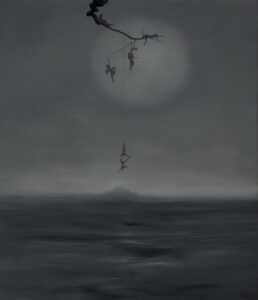
My 1976 No. 5/Paintings/Liu Qiming/ 59.1 W x 70.9 H x 2.8 D in/2007
留住个人的历史记忆
——谈刘骐鸣油画作品
王 林
在一个只推崇集体主义的社会中,即使是以人为本的思想也极易受到污染,当“人”变成“民”的时候,个人往往被排除在外。对中国封建主义文化传统而言,民和君相对,所谓“民为贵,君为轻,社稷次之”,民之重要在于它是君王统治的基础。这里有一个我们判断当今社会是否真正进入现代化的前提,即个人自由的优先权在社会体制和社会生活中的实现程度。宪法规定了每个公民的民主权利,而我们在现实生活中却根本无法实现。公民权名存实亡的现状,对中国人的精神心理产生了深刻的影响,大陆艺术家对于重大政治历史事件的集体失忆,就是一个显著的例证。众多艺术家在利用甚至滥用毛时代的文化资源,却几乎没有人对那样一个时代的历史灾难进行重述和反省。历史题材创作自伤痕美术浅尝辄止以来,至今仍然是官方意识形态全面主宰的领域,仍然是以政治倾向性取代历史真实性的所谓现实主义创作方法和叙事霸权肆虐的场地。
正因为如此,当我看到刘骐鸣把自己作品的关注点集结于历史记忆的时候,内心是充满感动的。
刘骐鸣从个人记忆的角度切入历史,无论是以年号为题,还是“革命样板”、“反恐精英”、“奥运畅想”等等以历史叙事为契机的作品,画家都没有对政治历史事件进行直接描绘。他总是用心理象征的手法,去叙说自己对于正在消逝的历史记忆的某种感触。比如《我的1989》系列作品,有的只是在天空中被悬置的稀微的人链,或者是在云水之上留下运动姿势的身影。这些已经被中国人在当今社会中集体遗忘的形象,在画面中显得那么渺小,那么虚幻。不仅是画家对于有意被抛弃的历史经历的哀戚,而且是艺术对于消费时代的精神现实的悲叹。正是在发自内心的哀戚与悲叹之中,艺术家希望留住个人的历史记忆。
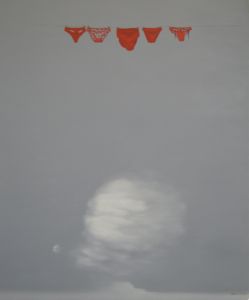
Year Of Life NO. 8/Paintings/Liu Qiming/ 59.1 W x 70.9 H x 2.8 D in/2008
这是诗意化的历史与历史化的诗意。
刘骐鸣的画面是空旷而寂寥、静谧而辽远的。他总是用灰暗的色彩——灰蓝、灰绿、或者是灰灰的淡红色——来构成朦胧的、含混的背景,甚至就是云水相接的画面本身。这中间有云水的波澜,有白日的晕辉,其间时隐时显的是典型的政治符号天安门。这种中国古典城楼出现在云水之间,有一种仙山琼廊的意象,为画家营造超现实情境增添了虚无飘渺的诗意。同时也以其政治象征,暗示出个人叙事的历史针对性。
画家对人的描绘是远距离的,空间的渺小与时间的消逝相互沟通。无论他们是在行走、在游弋,还是在做着运动的姿式、在树枝绳索上悬垂,画家有意利用透光的背景把他们画得如同剪影,轻薄、微小、飘浮,无根无源,无倚无靠,无始无终,无奈而又宿命。这是些被抛弃的人,被官方权利、被权利意识、被意识形态所抛弃、所遗忘的人。在市场经济、消费时代、集体社会混杂一体的当代中国,知识分子的整体坍塌、艺术创作的急功近利和历史意识的淡薄是互为表里的。刘骐鸣置身其中,对此深有所感。他在画面流露出深深的孤独和落寞,这种情绪是现场的也是真切的。唯其如此,艺术才能作为一种揭示,以其敏感、细微的心理反应揭示出精神现实的真实。
艺术创作并不一定要以对抗、对立的方式出现,才具有对于社会现实、精神现实和文化现实的批判性。艺术创作作为个人对生活的体验,其批判价值在于以个体化艺术语言去挑战既成、既定的集体话语。刘骐鸣作品执着于个人对历史事件的精神反应与心理追忆,本身就是对抹杀历史记忆的专制权利和集体意识的否定。在画面中刘骐鸣不断甚至是顽固地使用红色点线,不仅是在灰冷色调中提示视觉注意的形式需要,其红屋顶、红绳索、红领巾、红内裤等等,都是具有能指意义的政治符号或泛政治符号,只不过画家把它们异样化,抽离于现实生活而构置起超现实体验,通过历史的片断化、个别化、零散化,让历史还原成为个人的、心灵的、小写的历史。刘骐鸣以哀婉而凄楚的诗意去触摸历史,旨在证明历史是不能忘记的。其实,这句话本身就包含着对于历史的尊重,哪怕是曾经造成过巨大伤害的沉重的历史。也许这一点,正是刘骐鸣作品充满伤感诗意的原因。
谈刘骐鸣画作,令人想起当代德国画家基弗尔,他以泣血忏悔和入骨反省为德国民族二战以来的历史谱写了宏伟的哀歌。我总在想,中国画界开始有了如刘骐鸣这样低吟浅唱,流连于历史经历的作品,什么时候才能有如基弗尔一般为历史苦难发出道义强音的艺术家呢?
2008年6月15日
于四川美院桃花山侧
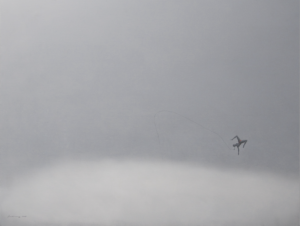
My 2008 No. 5/Paintings/Liu Qiming/ 59.1 W x 70.9 H x 2.8 D in/2008
